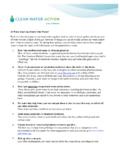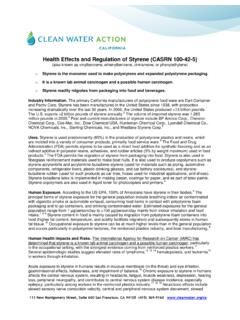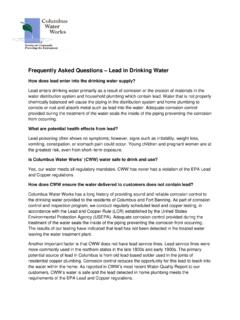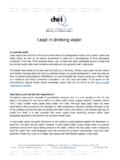Transcription of Lead and Drinking Water - Clean Water Action
1 Lead and Drinking WaterLead is a highly poisonous metal and can affect almost every organ in the body and the nervous system. People can be exposed to lead through inhalation, ingestion and to a lesser extent, dermal contact. The most common source of lead exposure is ingestion of old lead paint. Exposure to lead from Drinking Water is less common yet, as demonstrated in Flint, MI, lead in Water can have serious the Lead Out: To protect public health, we must reduce lead exposure at the Drinking Water tap. To make this a reality Clean Water Action is: advocating for proper implementation of the Safe Drinking Water Act s Lead and Copper Rule (LCR), including effective corrosion control at Drinking Water treatment plants to prevent lead leaching out of pipes and plumbing fixtures and monitoring to assess lead in Water systems; working for improvements in the LCR, which the US Environmental Protection Agency (EPA) will update in 2017.
2 And, supporting communities and Water systems in replacing lead service lines and taking other steps to get lead out of contact with Drinking Impacts of LeadCHILDRENK idneysAbnormal function and damageBloodAnemiaBrainBehavior problems, lower IQ, hearing loss, learning disabilitiesBodydecreased bone and muscle growthNervous SystemDamageBrainMemory loss, lack of concentration, headaches, irritability, D U LT SDigestive SystemConstipation, nausea and poor appetiteNervous SystemDamage including numbness and pain in the extremitiesBodyFatigue, joint and muscle painCardiovascularHigh blood pressureKidneysAbnormal function and damageReproductive SystemMen: Decreased sex drive and sperm count, and sperm anomalies.
3 Women: Spontaneous miscarriageExposure to high levels of lead can cause severe damage to the brain, blood and under six are most at risk from lead poisoning. Even low levels of lead exposure have been found to permanently reduce cognitive ability and cause hyperactivity in children. Learn about lead levels in your community. Every year, public Water systems prepare a Consumer Confidence Report (CCR), which includes information on lead monitoring results. For more information and help finding your CCR: Water systems also post lead monitoring results online. Have your Water tested. If you are concerned about lead in your tap Water you can test for lead and other contaminants.
4 Some Water systems will provide lead testing for their customers. Others will provide information on local laboratories and other resources. There are low cost tests available. Call your Water system to see if testing is available. Flush your pipes before Drinking or cooking. The longer Water sits in pipes, the more lead it may contain. Running the Water until becomes as cold as possible can help ensure that you are Drinking Water that has not been sitting still in your pipes. Use cold Water for Drinking and eating. Cold Water is less likely to contain lead. Never add warm Water to baby formula. Boiling Water will not remove lead.
5 Use Water filters or treatment devices. Only specific products are designed to reduce lead contamination. Learn more about products certified to reduce lead: SERVICE LINE*PUBLIC Water MAIN(Not a source of lead)Faucets, Fixtures and FittingsIn-Home PipesLead SolderCorroded PipesWATER METERT here are a number of ways that lead can enter Drinking Water . Older homes and pipes are more likely to contain lead, as lead has been phased out over time for most uses in Drinking Water distribution. Lead leaches out of pipes and other components if the Water is corrosive. Water systems add corrosion control chemicals that coat the pipes and prevent leaching.
6 Unlike many other Drinking Water contaminants that result from pollution of a Water source, Water does not generally contain lead before it enters the SERVICE LINE*Lead Service LinesPROPERTY BOUNDARY (CURB STOP)*Ownership of service lines varies across Water Lead Gets Into Drinking WaterProtect Yourself from Lead in Drinking Waterfor more information on lead in Drinking Water , go to.











